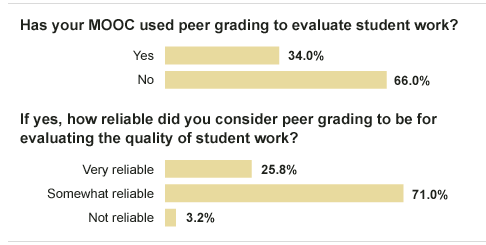In this post I’ve collected and commented on recent reports outlining several professors perspectives on the development of MOOCs, the teaching experience and how the instructional methods differ from traditional courses.
 What is it like to teach 10,000 or more students at once, and does it really work? (Kolowich, 2013). Excellent question—and now that Massive Open Online Courses [MOOCs] offered through providers such as Coursera have been around for a several months, we are starting to get data and insights from the professors in the trenches—those that have developed and facilitated the courses with thousands of students. The Chronicle of Higher Education shared results of a survey it conducted in February with professors from higher education institutions involved in teaching a MOOC. A total of 103 professors responded to an online questionnaire that was sent out to 184 professors that had recently taught, or were in the process of teaching a MOOC (Kolowich, 2013). Results are intriguing, and in some cases startling, for example the responses to a question on peer grading [see image below]:
What is it like to teach 10,000 or more students at once, and does it really work? (Kolowich, 2013). Excellent question—and now that Massive Open Online Courses [MOOCs] offered through providers such as Coursera have been around for a several months, we are starting to get data and insights from the professors in the trenches—those that have developed and facilitated the courses with thousands of students. The Chronicle of Higher Education shared results of a survey it conducted in February with professors from higher education institutions involved in teaching a MOOC. A total of 103 professors responded to an online questionnaire that was sent out to 184 professors that had recently taught, or were in the process of teaching a MOOC (Kolowich, 2013). Results are intriguing, and in some cases startling, for example the responses to a question on peer grading [see image below]:

Screen Shot from The Chronicle’s survey results on peer grading. http://www.chronicle.com/the-professors-behind-the-mooc
What I found fascinating was the change in professors’ attitudes towards MOOCs after they had finished teaching their own massive online course. Before teaching a MOOC, 29.7% respondents reported being ‘very enthusiastic’ about fully online courses, yet after the teaching experience, 55.9% reported being ‘very enthusiastic’. Hmm. Even the somewhat skeptical group changed their views after their MOOC experience. To read more results from the survey, click here.
Voices from the Survey
Included in The Chronicle’s coverage on the survey results, is a section that shares professors views on online learning, pedagogy and grading. It is an interesting read. To the right is one of the professor’s comments, which addresses a topic that may be worthy of further research. From the last two MOOCs I have completed with Coursera, I too have the impression that many active participants hold at least an undergraduate degree. Perhaps after identifying the demographic profile of the average student in a MOOC, course content and methods could be adapted accordingly. Click here to browse through the feedback from The Chronicle’s report.

Screen shot from Duke University report on development of Bioelectricity: A Quantitative Approach offered through Coursera in June 2012
The course involved over 600 hours in development and delivery, and the professor of the course, Dr. Roger Barr, invested 420 hours of the 600. The report also speaks of Dr. Barr’s extensive involvement in the discussion forums, as he devoted many hours to answering questions, reading posts and monitoring feedback.
Final Thoughts
What is becoming apparent after reviewing the reports mentioned in this post, and in conversations with several of my peers through Google+, etc, the time involved in teaching a MOOC is extensive, requiring an instructor’s undivided attention. I’ve heard of one or more professors teaching a MOOC while assuming his or her full teaching responsibilities at the university, which put tremendous pressure on the individual. Also apparent is the volume of upfront work that is required—an extensive amount of time is devoted to preparing the content, materials, instructions for students, and the course home page. There is still much more to learn about MOOCs. It is too early at this point to determine how this format will be most effective for learners, and which instructional design methods work best, but we are seeing emergent patterns and results, which are taking us in the right direction.
Further Reading
- The Professors Who Make the MOOCs, (2013), Steve Kolowich, The Chronicle
- MOOC Completion Rates: The Data, (2013) Katy Jordan
- Who Owns a MOOC?, (2013), Ry Rivard, Inside Higher Ed
- Duke University’s First MOOC review, (2013) Bioelectricity: A Quantitative Approach
- The Professor’s Big Stage, (2013), Thomas L. Friedman, New York Times

Reblogged this on Halina's Blog and commented:
MOOCs are becoming more and more popular.
LikeLike
Pingback: The online threat to the American professor | Edu Tips
Pingback: The online threat to the American professor | Ultra EDU
Pingback: The online threat to the American professor | College Leaf
Pingback: The online threat to the American professor | Business Education Tips
“Professors, Pedagogy and MOOCs | online learning insights” was indeed a
wonderful posting. If merely there were far more sites just like this excellent one on the actual world wide web.
Anyway, thank you for your time, Mike
LikeLike
Hi Mike,
Glad you liked the post! Thank for taking the time to comment! Debbie
LikeLike
We recently published an article exploring how MOOCs will affect copyright and fair use compliance. You may enjoy reading it as well: https://www.academicimpressions.com/news/how-will-moocs-affect-fair-use-and-copyright-compliance
LikeLike
Thanks for compiling some key parts of these reports. After all the conjecture, it’s great to be at this stage where we are starting to get some insight into the MOOC experience on either side of the fence.
The fact that most MOOC students already have higher education experience is unsurprising, but it is a reality check against all the accessibility and access talk around MOOCs.
LikeLike
Hi Ren, Glad you found something of interest in this post! I agree that the education level of a MOOC student is a reality check, and hope the institutions are taking notice. Debbie
LikeLike
Valuable information. We are in the “frontier days” of MOOCs. This kind of data will help in determining instructional strategies and load requirements for professors.
LikeLike
Yes we are, and I look forward to even more good data that will likely be published soon on MOOCs. Thanks for commenting and reading.
LikeLike
Pingback: Service Innovation In Action
Pingback: A Course, A Community? | Clyde Street
Pingback: Professors, Pedagogy and MOOCs | Halina's Blog
Thank you for such a convincing report.
It is clear that the instructional approaches shift from traditional ways.
There is also the time issue in 21st century teaching, also a MOOC. Majority of instructors needs to dedicate themselves to global online teaching which puts enormous emphasis on the university teacher.
Will this strategy benefit us in the right educational direction?
LikeLike